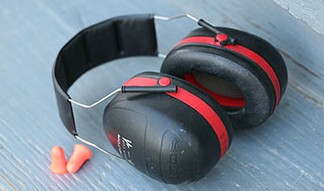This content has been archived as it may no longer be accurate or relevant.Emily Adams, Coshocton Tribune; 25 September 2015
Today marks the last day of National Farm Safety and Health Week. It’s a great time to remember the unique risks in farming that can affect our safety and health. Did you know that farm workers experience one of the highest rates of hearing loss among all occupations? Today we’ll look at why this is the case and some practical things you can do to reduce hearing loss.
There are a lot of noisy machines on a farm: tractors, combines, grain dryers, shotguns, and chain saws to name just a few. According to David Baker, University of Missouri Extension, the ear is a remarkable organ. It can respond to sounds ranging from dripping water to gunshots. The loudness of a sound is measured in decibels (dB). Typically, we begin to hear sounds at a threshold of 10 to 15 dB and normal conversation is about 60 dB. Noise from farm equipment like tractors is around 110 dB and chainsaws are at 120 dB.
The average person can be exposed to sounds producing 90 dB for a maximum of 8 hours a day. The rule of thumb is that a 5 dB increase in sound reduces the exposure time without protection by half. So moving up to 100 dB of sound level reduces the maximum exposure to only 2 hours.
Some of the most common effects of hearing loss are ringing in the ears and interference with communication. After exposure to loud sound many people experience symptoms of temporary hearing loss, including ringing in the ears. After prolonged exposure this ringing can be constant. Another effect of permanent damage is the loss of ability to process high-frequency sounds. This makes understanding especially women’s and children’s voices more difficult.
So what can you do to reduce your exposure to agricultural noise? Two ways are engineering controls and personal protection equipment. Newer tractors are designed with protective cabs that reduce noise exposure. But even with older equipment, you can make sure that machine parts are well-lubricated to cut down on noise exposure. A high-quality muffler and replacing worn, loose or unbalanced machine parts will reduce vibrations as well.
And one of the simplest and best things you can do is to wear ear protection. The two basic types are earplugs and earphones. When worn correctly, they are both effective at reducing noise. The important thing is to make them available when you need them. Make sure that either earmuffs or earplugs are kept near the equipment that you will use. One tip is to keep earplugs wherever you keep your keys and cell phone. When you grab these essentials on your way out the door, be sure to grab the earplugs as well.
When using earplugs, be sure that you are inserting them properly. Check out this YouTube video that shows the proper way at go.osu.edu/earplugs. They are certainly an inexpensive and simple way to protect one of our greatest gifts.
Click here to see the original article
Share this Post

